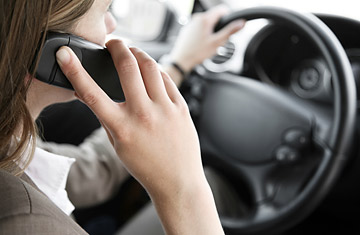
If you’re one of those annoying motorists with his hand cupped to his ear yakking away on a cell phone — and you know who you are — better be careful where you’re driving.
This month, California and Washington State joined Connecticut, New Jersey, New York and the District of Columbia in enacting laws prohibiting driving while talking on a handheld cell phone. Motorists who want to gab on the phone in those states are required to use a hands-free device — a wired headset, wireless earpiece or speakerphone — that lets them keep both hands on the wheel.
Already, more than 1,000 California motorists have been issued citations since the hands-free law went into effect, according to the California Highway Patrol. The base fine for the first offense in California is $20, and subsequent convictions are $50. With the addition of penalty assessments, the fines can more than triple.
Prohibiting a single act like talking on a handheld cell phone may sound simple enough. But keeping track of the confusing patchwork of cell phone laws around the country is enough to drive motorists to distraction. For example, if you’re driving by the Lincoln Memorial in Washington, D.C., you’re required by law to use a hands-free device while talking on your cell phone. A minute later, as you cross the Memorial Bridge into Virginia, you’re free to put the phone back up to your ear. In New York, an officer can pull you over simply for talking on a handheld cell phone. But in Washington State, you can’t be cited solely for a cell phone violation; there has to be another traffic offense taking place at the same time.
In California, the new hands-free law contains several surprising loopholes. The statute doesn’t explicitly prohibit drivers from dialing a cell phone, although motorists are strongly urged not to dial while driving. Of course, dialing while driving is even more dangerous than talking, since you have to take your eyes off the road to look at the keypad.
The California statute also lets drivers use a standard handheld cell phone to make an emergency call. The law lists emergency calls as those to a law enforcement agency, medical provider, fire department or other emergency services agency. But some motorists pulled over by the highway patrol have their own notions of what constitutes an emergency.
“I’ve already heard a lot of excuses,” says officer Allyn Ball of the California Highway Patrol, who has issued about 15 citations since the hands-free law went into effect. “Some people have said, ‘I really needed to take this call for my business.’ I tell them, ‘Sorry.'”
Even more astounding, the California law does not specifically prohibit text messaging while driving, although an officer can issue a citation if he believes the driver is not operating the vehicle safely. When the California law was first proposed in 2001, texting wasn’t nearly as popular as it is now, and the language of the law never caught up with the times. Another bill has been introduced in the state legislature that covers texting, but until then, drivers in the Golden State are free to barrel down the freeway while manically thumbing their keypads. But don’t get too cocky with your on-the-road texting. Drivers in four states — Alaska, Minnesota, New Jersey and Washington — can be cited for an infraction that in many ways defines the age of multitasking: DWT, or driving while texting.
Until recently, the cell phone industry has opposed hands-free laws, vigorously defending the right of Americans to drive with only one hand on the wheel while jabbering on the phone. California state senator Joe Simitian, author of the state’s hands-free law, spent six years trying to get the bill passed against heavy lobbying by wireless firms. Every major phone carrier except Verizon initially opposed the bill, arguing that it unfairly singled out cell phones from a range of driver distractions; by the time the bill was signed last year, only Sprint was still against it, and even they have since changed their stance.
“Every single one of the cell phone companies that opposed the bill also published consumer brochures that said very explicitly, ‘You should never drive while holding a cell phone to your ear,'” says Simitian.
The hands-free laws are based on what seems like no-brainer logic: a driver with two hands on the wheel is a safer driver. A study released earlier this year by the Public Policy Institute of California estimated that 300 fewer people a year will die in traffic accidents in California as a result of the new law.
But it’s unclear whether hands-free laws alone will make the roads safer. Numerous studies have concluded that any type of cell phone use — hands-free or not — can distract a driver enough to increase the likelihood of an accident. According to research conducted by Carnegie Mellon University neuroscientist Marcel Just, simply listening intently to a cell phone conversation is enough to impair driving. And a 2004 study from the National Highway Traffic Safety Administration found that drivers using hand-free cell phones had to redial calls 40% of the time, compared with 18% for drivers using handheld sets, suggesting that hands-free devices may in some cases lead to more distraction.
So far, there’s only one surefire way for motorists to stay safe and alert and to comply with all existing laws: hang up and drive.
& pls no txtng.